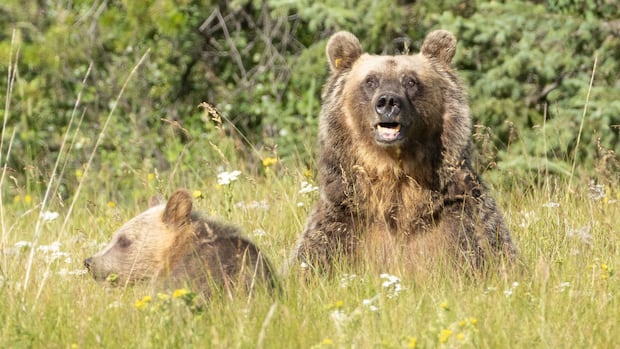Alberta Fish and Wildlife Enforcement Services is continuing to investigate the mauling of a hunter by a grizzly bear Thursday in the Springbank area, located west of Calgary.
The grizzly that attacked the man was shot and killed by his hunting partner, while another bear fled the scene following the attack, according to the province.
An Alberta Fish and Wildlife spokesperson said the age and status of the bear that fled the scene are unknown. Minister of Forestry and Parks Todd Loewen told CBC News it’s believed the two were a mother-cub pair.
The fate of that second bear depends on multiple factors, said retired Alberta Fish and Wildlife officer John Clarke.
“A sow grizzly will hang on to her cubs, or her kids, until they’re about three,” Clarke said. “Was it born in February, or was it a yearling, or a two-year-old?”
He said if it is old enough to survive without its mother, Alberta Fish and Wildlife might leave it be.
“Hopefully it doesn’t get in trouble after. The cub’s really done nothing,” Clarke said. “What’s his offence? He was just being with mom, right?”
Context of human-grizzly conflict matters
According to the province’s grizzly bear response guide, the available options for an orphaned cub are retaining at a zoo, taking no action, or euthanasia. Relocation in the wild is not an option for bears under a year old.
Under the provincial Wildlife Act, orphaned grizzly bears cannot be rehabilitated and released back into the wild, unlike black bears.
Two grizzly bear cubs were brought to the Wilder Institute/Calgary Zoo in September after their mother was killed by a hunter in self-defence near Diamond Valley. They’ll be staying there permanently, the zoo said earlier this month.

Alberta Fish and Wildlife says DNA samples are being collected to confirm the bear that was killed was the one responsible for the attack. As of Friday, no further update has been provided by the province regarding the investigation.
On Friday, EMS said the mauling victim was in non-life-threatening condition, but that he was in serious condition when he was airlifted to hospital by STARS air ambulance.
Minister says grizzlies moving ‘closer to civilization’
Loewen, the forestry and parks minister, said the mauling’s proximity to Calgary demonstrates that grizzly bears are expanding their range in Alberta.
“There’s no doubt that we’re seeing grizzlies closer and closer to civilization, and we’re seeing them in areas that we haven’t seen them before,” he said.
The province’s grizzly bear management plan includes core areas, where grizzly bears are expected to roam and reproduce, and support areas, where it’s not uncommon for them to appear. Loewen said grizzlies are being encountered further east and north of those areas at an increasing rate.
“You can encounter grizzlies just about anywhere nowadays,” he said.
In a release last year, the province said Alberta’s grizzly bear population had “increased from approximately 800 to more than 1,150 now, causing them to move into more populated areas.”
A 2021 government release estimated the province’s grizzly population was “between 865 and 973” bears, using data based on surveys conducted in 2018.
Loewen has said the province is concerned about the number of grizzly bear attacks on livestock.
Alberta Fish and Wildlife says there have been 62 confirmed reports of grizzly bears killing livestock this year.
Thursday’s mauling was one of three grizzly bear attacks the province says it has responded to this year, including a non-fatal mauling along the St. Mary River near Cardston, about 235 kilometres south of Calgary, in August, and the Diamond Valley encounter in September that left two cubs orphaned and in the permanent care of the Wilder Institute/Calgary Zoo.


